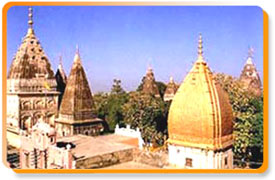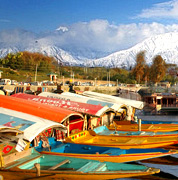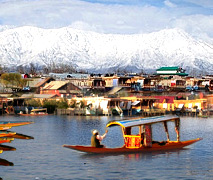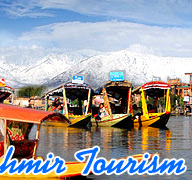 d in the foothills of the Himalayas, is the
place that Raja Jambu Lochan discovered one day along the River Tawi,
while he was on a hunting trip. To his surprise, he found that a tiger
and a goat stood side-by-side, drinking water from the same place in the
Tawi River. He was so struck by this unusual sight that he decided to
build a city here where no living creature seemed to bear enmity towards
each other. Today, as if in testimony to Raja Jambu Lochan's vision, the
city of Jammu has come to be known as the 'City Of Temples'.
Innumerable temples and shrines with 'shikhars' soaring into the sky
create the ambience of a holy and peaceful city.
d in the foothills of the Himalayas, is the
place that Raja Jambu Lochan discovered one day along the River Tawi,
while he was on a hunting trip. To his surprise, he found that a tiger
and a goat stood side-by-side, drinking water from the same place in the
Tawi River. He was so struck by this unusual sight that he decided to
build a city here where no living creature seemed to bear enmity towards
each other. Today, as if in testimony to Raja Jambu Lochan's vision, the
city of Jammu has come to be known as the 'City Of Temples'.
Innumerable temples and shrines with 'shikhars' soaring into the sky
create the ambience of a holy and peaceful city. Amongst the temples in Jammu, the Raghunath Mandir takes pride of place being situated right in the heart of the city. This temple is situated at the city centre and was built in 1857. This temple consists of seven shrines, each with a tower of its own. It is the largest temple complex in northern India. Though 130 years old, the complex is remarkable for sacred scriptures, one of the richest collections of ancient texts and manuscripts in its library. Its arches, surface and niches are undoubtedly influenced by Mughal architecture while the interiors of the temple are plated with gold. The main sanctuary is dedicated to Vishnu's eighth incarnation and Dogras' patron deity, the Rama. It also houses a Sanskrit Library containing rare Sanskrit manuscripts.
The famous temple of Bawey Wali Mata inside the Bahu Fort attracts pilgrims every Tuesday and Sunday who come here to worship the presiding deity of Jammu while opposite the Bahu Fort, overlooking the River Tawi is a temple dedicated to Mahamaya, a local heroine of Dogras, who lost her life fourteen centuries ago fighting foreign invaders. The present temple of Bawey Wali Mata was built shortly after the coronation of Maharaja Gulab Singh, in 1822. It is also known as the temple of Mahakali and the goddess is considered second only to Mata Vaishno Devi in terms of mystical power. Alongside the same river are the Peer Kho Cave temple, the Panchbakhtar temple and the Ranbireshwar temple dedicated to Lord Shiva with their own legends and specific days of worship. The Ranbireshwar Temple has twelve Shiva 'lingams' of crystal measuring 12" to 18" and galleries with thousands of 'saligrams' fixed on stone slabs.
The Dargah (shrine) of Peer Budhan Ali Shah or Peer Baba is said to protect the people of this city from mishaps and evil spirits. A friend of Guru Gobind Singh, it is said that Peer Baba lived his entire life on milk alone and lived to the age of five hundred and still people from all faiths and religions verate him in equal respect. Peer Mitha was a saint who has a shrine of his own and was a contemporary of Ajaib Dev and Ghareeb Nath, who were famous for their prophecies and miracles. 'Mitha' means 'the sweet one' and the saint was so-called, as the Peer would accept nothing more than a pinch of sugar in offering from his devotees.
Worship of Shakti is prevalent in all parts of Jammu province and the best known of the Shakti shrines is the temple of Vaishno Devi, which holds the same status in Jammu as the Amarnath cave has in Kashmir. 61 km north of Jammu, this cave temple is dedicated to Mahakali, Mahalaxmi and Mahasaraswati, the three mother goddesses of Hinduism. The cave is one of the region's most important pilgrim sites. There is a 13 km track to the cave temple and the ponies, porters and dandies are available from Katra to cave temple in a fixed rate.










